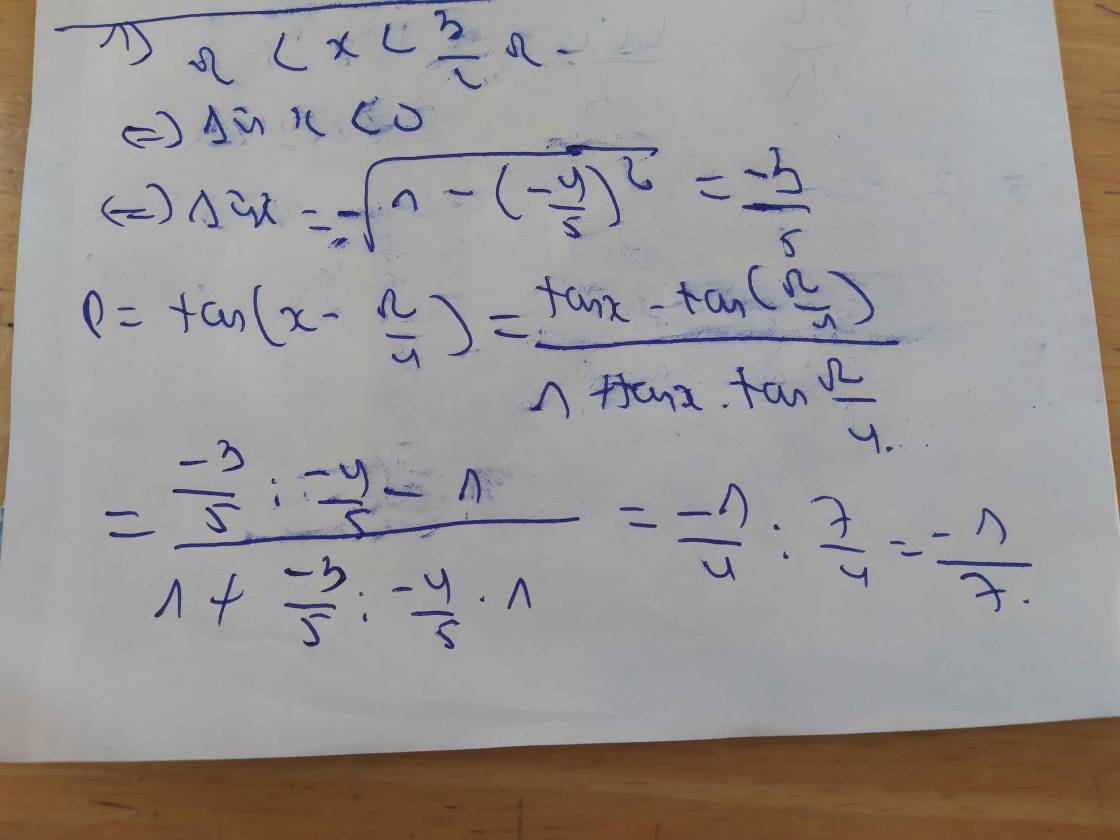Cho $\cos x=-\dfrac{1}{3}$ và $\dfrac{\pi }{2}<x<\pi $ . Tính $\sin 2x\,;\,\,\cos 2x\,;\,\,\tan \left( x-\dfrac{\pi }{4} \right).$
Hãy nhập câu hỏi của bạn vào đây, nếu là tài khoản VIP, bạn sẽ được ưu tiên trả lời.


a: 3/2pi<x<2pi
=>sin x<0
=>\(sinx=-\sqrt{1-\left(\dfrac{1}{6}\right)^2}=-\dfrac{\sqrt{35}}{6}\)
\(sin2x=2\cdot sinx\cdot cosx=2\cdot\dfrac{1}{6}\cdot\dfrac{-\sqrt{35}}{6}=\dfrac{-\sqrt{35}}{18}\)
\(cos2x=2\cdot cos^2x-1=2\cdot\dfrac{1}{36}-1=\dfrac{1}{18}-1=\dfrac{-17}{18}\)
\(tan2x=\dfrac{-\sqrt{35}}{18}:\dfrac{-17}{18}=\dfrac{\sqrt{35}}{17}\)
\(cot2x=1:\dfrac{\sqrt{35}}{17}=\dfrac{17}{\sqrt{35}}\)
b: \(sin\left(\dfrac{pi}{3}-x\right)\)
\(=sin\left(\dfrac{pi}{3}\right)\cdot cosx-cos\left(\dfrac{pi}{3}\right)\cdot sinx\)
\(=\dfrac{1}{2}\cdot\dfrac{-\sqrt{35}}{6}-\dfrac{1}{2}\cdot\dfrac{1}{6}=\dfrac{-\sqrt{35}-1}{12}\)
c: \(cos\left(x-\dfrac{3}{4}pi\right)\)
\(=cosx\cdot cos\left(\dfrac{3}{4}pi\right)+sinx\cdot sin\left(\dfrac{3}{4}pi\right)\)
\(=\dfrac{1}{6}\cdot\dfrac{-\sqrt{2}}{2}+\dfrac{-\sqrt{35}}{6}\cdot\dfrac{\sqrt{2}}{2}=\dfrac{-\sqrt{2}-\sqrt{70}}{12}\)
d: tan(pi/6-x)
\(=\dfrac{tan\left(\dfrac{pi}{6}\right)-tanx}{1+tan\left(\dfrac{pi}{6}\right)\cdot tanx}\)
\(=\dfrac{\dfrac{\sqrt{3}}{3}-\sqrt{35}}{1+\dfrac{\sqrt{3}}{3}\cdot\left(-\sqrt{35}\right)}\)

a: pi/2<x<pi
=>cosx<0
=>\(cosx=-\sqrt{1-\left(\dfrac{1}{5}\right)^2}=-\dfrac{2\sqrt{6}}{5}\)
\(sin2x=2\cdot sinx\cdot cosx=2\cdot\dfrac{1}{5}\cdot\dfrac{-2\sqrt{6}}{5}=\dfrac{-4\sqrt{6}}{25}\)
\(cos2x=2\cdot cos^2x-1=2\cdot\dfrac{24}{25}-1=\dfrac{48}{25}-1=\dfrac{23}{25}\)
\(tan2x=-\dfrac{4\sqrt{6}}{25}:\dfrac{23}{25}=-\dfrac{4\sqrt{6}}{23}\)
\(cot2x=1:\dfrac{-4\sqrt{6}}{23}=\dfrac{-23}{4\sqrt{6}}\)
b: \(sin\left(x-\dfrac{pi}{6}\right)=sinx\cdot cos\left(\dfrac{pi}{6}\right)-cosx\cdot sin\left(\dfrac{pi}{6}\right)\)
\(=sinx\cdot\dfrac{\sqrt{3}}{2}-cosx\cdot\dfrac{1}{2}\)
\(=\dfrac{1}{5}\cdot\dfrac{\sqrt{3}}{2}-\dfrac{-2\sqrt{6}}{5}\cdot\dfrac{1}{2}=\dfrac{\sqrt{3}+2\sqrt{6}}{10}\)
c: \(cos\left(x-\dfrac{pi}{3}\right)=cosx\cdot cos\left(\dfrac{pi}{3}\right)+sinx\cdot sin\left(\dfrac{pi}{3}\right)\)
\(=-\dfrac{2\sqrt{6}}{5}\cdot\dfrac{1}{2}+\dfrac{1}{5}\cdot\dfrac{1}{2}=\dfrac{-2\sqrt{6}+1}{10}\)
d: \(tan\left(x-\dfrac{pi}{4}\right)=\dfrac{tanx-tan\left(\dfrac{pi}{4}\right)}{1+tanx\cdot tan\left(\dfrac{pi}{4}\right)}\)
\(=\dfrac{tanx-1}{1+tanx}\)
\(=\dfrac{\dfrac{1}{-2\sqrt{6}}-1}{1+\dfrac{1}{-2\sqrt{6}}}=\dfrac{-25-4\sqrt{6}}{23}\)

a) Để tính sin2x, cos2x, tan2x và cot2x, chúng ta cần biết giá trị của cosx trước đã. Theo như bạn đã cho, cosx = -1/4. Vậy sinx sẽ bằng căn bậc hai của 1 - cos^2(x) = căn bậc hai của 1 - (-1/4)^2 = căn bậc hai của 1 - 1/16 = căn bậc hai của 15/16 = sqrt(15)/4. Sau đó, chúng ta có thể tính các giá trị khác như sau: sin2x = (2sinx*cosx) = 2 * (sqrt(15)/4) * (-1/4) = -sqrt(15)/8 cos2x = (2cos^2(x) - 1) = 2 * (-1/4)^2 - 1 = 2/16 - 1 = -14/16 = -7/8 tan2x = sin2x/cos2x = (-sqrt(15)/8) / (-7/8) = sqrt(15) / 7 cot2x = 1/tan2x = 7/sqrt(15) b) Để tính sin(x + 5π/6), chúng ta có thể sử dụng công thức sin(a + b) = sin(a)cos(b) + cos(a)sin(b). Với a = x và b = 5π/6, ta có: sin(x + 5π/6) = sin(x)cos(5π/6) + cos(x)sin(5π/6) = sin(x)(-sqrt(3)/2) + cos(x)(1/2) = (-sqrt(3)/2)sin(x) + (1/2)cos(x) c) Để tính cos(π/6 - x), chúng ta sử dụng công thức cos(a - b) = cos(a)cos(b) + sin(a)sin(b). Với a = π/6 và b = x, ta có: cos(π/6 - x) = cos(π/6)cos(x) + sin(π/6)sin(x) = (√3/2)cos(x) + 1/2sin(x) d) Để tính tan(x + π/3), chúng ta có thể sử dụng công thức tan(a + b) = (tan(a) + tan(b))/(1 - tan(a)tan(b)). Với a = x và b = π/3, ta có: tan(x + π/3) = (tan(x) + tan(π/3))/(1 - tan(x)tan(π/3))
a: pi/2<x<pi
=>sin x>0
=>\(sinx=\sqrt{1-\left(-\dfrac{1}{4}\right)^2}=\dfrac{\sqrt{15}}{4}\)
\(sin2x=2\cdot sinx\cdot cosx=2\cdot\dfrac{\sqrt{15}}{4}\cdot\dfrac{-1}{4}=\dfrac{-\sqrt{15}}{8}\)
\(cos2x=2\cdot cos^2x-1=2\cdot\dfrac{1}{16}-1=-\dfrac{7}{8}\)
\(tan2x=-\dfrac{\sqrt{15}}{8}:\dfrac{-7}{8}=\dfrac{\sqrt{15}}{7}\)
\(cot2x=1:\dfrac{\sqrt{15}}{7}=\dfrac{7}{\sqrt{15}}\)
b: sin(x+5/6pi)
=sinx*cos(5/6pi)+cosx*sin(5/6pi)
\(=\dfrac{\sqrt{15}}{4}\cdot\dfrac{-\sqrt{3}}{2}+\dfrac{1}{2}\cdot\dfrac{-1}{4}=\dfrac{-\sqrt{45}-1}{8}\)
c: cos(pi/6-x)
=cos(pi/6)*cosx+sin(pi/6)*sinx
\(=\dfrac{\sqrt{3}}{2}\cdot\dfrac{-1}{4}+\dfrac{1}{2}\cdot\dfrac{\sqrt{15}}{4}=\dfrac{-\sqrt{3}+\sqrt{15}}{8}\)
d: tan(x+pi/3)
\(=\dfrac{tanx+tan\left(\dfrac{pi}{3}\right)}{1-tanx\cdot tan\left(\dfrac{pi}{3}\right)}\)
\(=\dfrac{-\sqrt{15}+\sqrt{3}}{1+\sqrt{15}\cdot\sqrt{3}}=\dfrac{-\sqrt{15}+\sqrt{3}}{1+3\sqrt{5}}\)

a)
$cos\left(x+\frac{\pi }{6}\right)=\frac{4}{5}cos\left(\frac{\pi }{6}\right)-\left(-\frac{3}{5}\right)sin\left(\frac{\pi }{6}\right)=\frac{4}{5}.\frac{\sqrt{3}}{2}+\frac{3}{5}.\frac{1}{2}=\frac{3+4\sqrt{3}}{10}$
b) $tan(x + \frac{\pi}{4}) = \frac{-3/5 + 1}{1 + (-3/5)(1)} = \frac{-2/5}{2/5} = -1$

a.
\(y'=\dfrac{3}{cos^2\left(3x-\dfrac{\pi}{4}\right)}-\dfrac{2}{sin^2\left(2x-\dfrac{\pi}{3}\right)}-sin\left(x+\dfrac{\pi}{6}\right)\)
b.
\(y'=\dfrac{\dfrac{\left(2x+1\right)cosx}{2\sqrt{sinx+2}}-2\sqrt{sinx+2}}{\left(2x+1\right)^2}=\dfrac{\left(2x+1\right)cosx-4\left(sinx+2\right)}{\left(2x+1\right)^2}\)
c.
\(y'=-3sin\left(3x+\dfrac{\pi}{3}\right)-2cos\left(2x+\dfrac{\pi}{6}\right)-\dfrac{1}{sin^2\left(x+\dfrac{\pi}{4}\right)}\)

a.
\(\sqrt{2}sin\left(2x+\dfrac{\pi}{4}\right)=3sinx+cosx+2\)
\(\Leftrightarrow sin2x+cos2x=3sinx+cosx+2\)
\(\Leftrightarrow2sinx.cosx-3sinx+2cos^2x-cosx-3=0\)
\(\Leftrightarrow sinx\left(2cosx-3\right)+\left(cosx+1\right)\left(2cosx-3\right)=0\)
\(\Leftrightarrow\left(2cosx-3\right)\left(sinx+cosx+1\right)=0\)
\(\Leftrightarrow\left[{}\begin{matrix}cosx=\dfrac{3}{2}\left(vn\right)\\sinx+cosx+1=0\end{matrix}\right.\)
\(\Rightarrow\sqrt{2}sin\left(x+\dfrac{\pi}{4}\right)=-1\)
\(\Leftrightarrow sin\left(x+\dfrac{\pi}{4}\right)=-\dfrac{\sqrt{2}}{2}\)
\(\Leftrightarrow...\)
b.
ĐKXĐ: \(cosx\ne\dfrac{1}{2}\Rightarrow\left[{}\begin{matrix}x\ne\dfrac{\pi}{3}+k2\pi\\x\ne-\dfrac{\pi}{3}+k2\pi\end{matrix}\right.\)
\(\dfrac{\left(2-\sqrt{3}\right)cosx-2sin^2\left(\dfrac{x}{2}-\dfrac{\pi}{4}\right)}{2cosx-1}=1\)
\(\Rightarrow\left(2-\sqrt{3}\right)cosx+cos\left(x-\dfrac{\pi}{2}\right)=2cosx\)
\(\Leftrightarrow-\sqrt{3}cosx+sinx=0\)
\(\Leftrightarrow sin\left(x-\dfrac{\pi}{3}\right)=0\)
\(\Rightarrow x-\dfrac{\pi}{3}=k\pi\)
\(\Rightarrow x=\dfrac{\pi}{3}+k\pi\)
Kết hợp ĐKXĐ \(\Rightarrow x=\dfrac{4\pi}{3}+k2\pi\)

1.
\(2cos\left(a+b\right)=cosa.cos\left(\pi+b\right)\)
\(\Leftrightarrow2cosa.cosb-2sina.sinb=-cosa.cosb\)
\(\Leftrightarrow2sina.sinb=3cosa.cosb\Rightarrow4sin^2a.sin^2b=9cos^2a.cos^2b\)
\(\Rightarrow4\left(1-cos^2a\right)\left(1-cos^2b\right)=9cos^2a.cos^2b\)
\(\Leftrightarrow4-4\left(cos^2a+cos^2b\right)=5cos^2a.cos^2b\)
\(A=\dfrac{1}{cos^2a+2\left(sin^2a+cos^2a\right)}+\dfrac{1}{cos^2b+2\left(sin^2b+cos^2b\right)}\)
\(=\dfrac{1}{2+cos^2a}+\dfrac{1}{2+cos^2b}=\dfrac{4+cos^2a+cos^2b}{4+2\left(cos^2a+cos^2b\right)+cos^2a.cos^2b}\)
\(=\dfrac{4+cos^2a+cos^2b}{4+2\left(cos^2a+cos^2b\right)+\dfrac{4}{5}-\dfrac{4}{5}\left(cos^2a+cos^2b\right)}=\dfrac{4+cos^2a+cos^2b}{\dfrac{24}{5}+\dfrac{6}{5}\left(cos^2a+cos^2b\right)}=\dfrac{5}{6}\)
2.
\(A=2cos\dfrac{2x}{3}\left(cos\dfrac{2\pi}{3}+cos\dfrac{4x}{3}\right)=2cos\dfrac{2x}{3}\left(cos\dfrac{4x}{3}-\dfrac{1}{2}\right)\)
\(=2cos\dfrac{2x}{3}.cos\dfrac{4x}{3}-cos\dfrac{2x}{3}\)
\(=cos3x+cos\dfrac{2x}{3}-cos\dfrac{2x}{3}\)
\(=cos3x\)
\(B=\dfrac{cos2b-cos2a}{cos^2a.sin^2b}-tan^2a.cot^2b=\dfrac{1-2sin^2b-\left(1-2sin^2a\right)}{cos^2a.sin^2b}-tan^2a.cot^2b\)
\(=\dfrac{2sin^2a-2sin^2b}{cos^2a.sin^2b}-tan^2a.cot^2b=2tan^2a\left(1+cot^2b\right)-2\left(1+tan^2a\right)-tan^2a.cot^2b\)
\(=2tan^2a+2tan^2a.cot^2b-2-2tan^2a-tan^2a.cot^2b\)
\(=tan^2a.cot^2b-2\)

